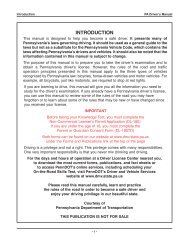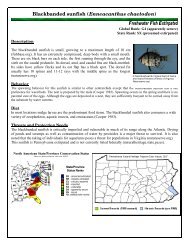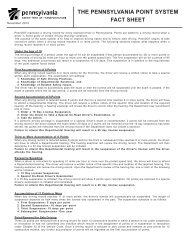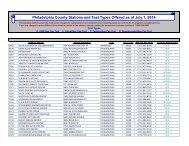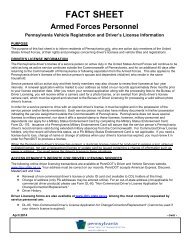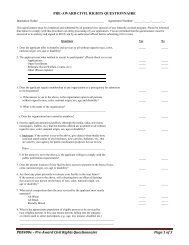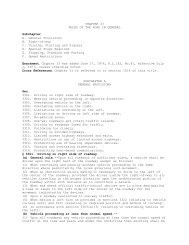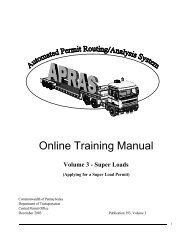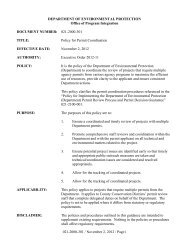fundamentals of driving a school bus - PennDOT Driver and Vehicle ...
fundamentals of driving a school bus - PennDOT Driver and Vehicle ...
fundamentals of driving a school bus - PennDOT Driver and Vehicle ...
- No tags were found...
You also want an ePaper? Increase the reach of your titles
YUMPU automatically turns print PDFs into web optimized ePapers that Google loves.
UNIT G - Fundamentals <strong>of</strong> Driving a School BusSTOPPING PROCEDURES FOR STANDARD TRANSMISSIONSDifferent procedures are required for stopping at low <strong>and</strong> high speeds or on an upgrade or downgrade. If youstop the <strong>bus</strong> for more than several minutes in a non-traffic situation, turn <strong>of</strong>f the engine. This not only conservesfuel, but eliminates the possibility <strong>of</strong> poisonous carbon monoxide exhaust fumes entering the <strong>bus</strong>.Low Speed StoppingWhen you are in a low gear or are traveling 10 mph or less, use the following stopping procedures:1. Release the accelerator <strong>and</strong> when speed decreases to 3 to 5 mph, press the clutch pedal;2. Apply the brakes gradually by increasing pressure;3. To prevent the <strong>bus</strong> from jerking, reduce the brake pressure slightly, but not completely just beforecoming to a stop;4. Place the gear shift lever into the neutral position; <strong>and</strong>5. Release the clutch <strong>and</strong> remove foot from the clutch.Stopping at Speeds Greater than 10 MPHWhen traveling in a higher gear, the procedure for stopping is as follows:1. Release the accelerator <strong>and</strong> press the brake pedal;2. When you reach the minimum speed for the next lower gear, downshift to that gear. Using the lowergear will reduce the buildup <strong>of</strong> heat <strong>and</strong> avoid excessive brake wear. This is also the case for automatictransmissions; <strong>and</strong>3. Downshifting can be very effective <strong>and</strong> smooth if you use third gear for the slowing action in five-speedtransmissions, <strong>and</strong> second gear in four-speed transmissions.Stopping on an UpgradeWhen coming to a stop on an upgrade, you should:1. Be aware <strong>of</strong> the traffic behind you;2. Apply pressure on the foot brake lightly for a smooth stop;3. Press clutch with left foot; shift into neutral;4. Hold <strong>bus</strong> with h<strong>and</strong> brake, if necessary. Don’t use the clutch as a brake; <strong>and</strong>5. Allow an extra safety margin <strong>of</strong> space between the <strong>bus</strong> <strong>and</strong> the vehicle ahead.Stopping on a DowngradeWhen coming to a stop on a downgrade, stop as you would on an upgrade, except downshift to reduce speedas necessary. If the downgrade is quite long <strong>and</strong>/or steep, use the “snub” braking technique discussed later inthis unit.CHECKING OVERHEAD CLEARANCEHitting overhead objects is a danger. A typical <strong>school</strong> <strong>bus</strong> is not more than 12 feet in height, so make sure youalways have enough room overhead. This not only includes on-the-road hazards, such as low hanging wires,overhanging branches, etc., but overhead hazards in your <strong>bus</strong> storage location such as wash bays <strong>and</strong> garageentrances. The clearance requirement for wires over a roadway is 18 feet, but over driveways is only 15 feet.This is a significant difference <strong>and</strong> one to be aware <strong>of</strong> if you have to turn a <strong>bus</strong> around, especially if the wiresappear to be hanging low.Pennsylvania School Bus <strong>Driver</strong>’s Manual • PUB 117 G-15



